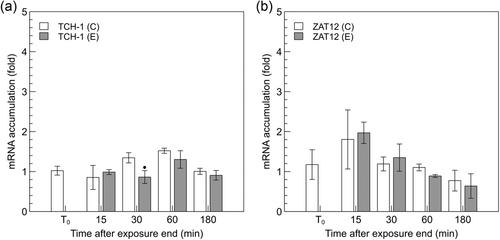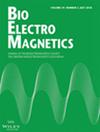下载PDF
{"title":"拟南芥暴露于纳秒级高幅电磁场脉冲后的基因表达变化。","authors":"Alexis Porcher, Nancy Wilmot, Pierre Bonnet, Vincent Procaccio, Alain Vian","doi":"10.1002/bem.22475","DOIUrl":null,"url":null,"abstract":"<p>The biological effects of exposure to electromagnetic fields due to wireless technologies and connected devices are a subject of particular research interest. Ultrashort high-amplitude electromagnetic field pulses delivered to biological samples using immersed electrodes in a dedicated cuvette have widely demonstrated their effectiveness in triggering several cell responses including increased cytosolic calcium concentration and reactive oxygen species (ROS) production. In contrast, the effects of these pulses are poorly documented when electromagnetic pulses are delivered through an antenna. Here we exposed <i>Arabidopsis thaliana</i> plants to 30,000 pulses (237 kV m<sup>−1</sup>, 280 ps rise-time, duration of 500 ps) emitted through a Koshelev antenna and monitored the consequences of electromagnetic fields exposure on the expression levels of several key genes involved in calcium metabolism, signal transduction, ROS, and energy status. We found that this treatment was mostly unable to trigger significant changes in the messenger RNA accumulation of calmodulin, Zinc-Finger protein <i>ZAT12</i>, NADPH oxidase/respiratory burst oxidase homolog (<i>RBOH</i>) isoforms D and F, Catalase (<i>CAT2</i>), glutamate-cystein ligase (<i>GSH1</i>), glutathione synthetase (<i>GSH2</i>), Sucrose non-fermenting-related Kinase 1 (<i>SnRK1</i>) and Target of rapamycin (<i>TOR</i>). In contrast, Ascorbate peroxidases <i>APX-1</i> and APX-6 were significantly induced 3 h after the exposure. These results suggest that this treatment, although quite strong in amplitude, is mostly ineffective in inducing biological effects at the transcriptional level when delivered by an antenna. © 2023 The Authors. Bioelectromagnetics published by Wiley Periodicals LLC on behalf of Bioelectromagnetics Society.</p>","PeriodicalId":8956,"journal":{"name":"Bioelectromagnetics","volume":null,"pages":null},"PeriodicalIF":1.8000,"publicationDate":"2023-07-06","publicationTypes":"Journal Article","fieldsOfStudy":null,"isOpenAccess":false,"openAccessPdf":"https://onlinelibrary.wiley.com/doi/epdf/10.1002/bem.22475","citationCount":"0","resultStr":"{\"title\":\"Changes in Gene Expression After Exposing Arabidopsis thaliana Plants to Nanosecond High Amplitude Electromagnetic Field Pulses\",\"authors\":\"Alexis Porcher, Nancy Wilmot, Pierre Bonnet, Vincent Procaccio, Alain Vian\",\"doi\":\"10.1002/bem.22475\",\"DOIUrl\":null,\"url\":null,\"abstract\":\"<p>The biological effects of exposure to electromagnetic fields due to wireless technologies and connected devices are a subject of particular research interest. Ultrashort high-amplitude electromagnetic field pulses delivered to biological samples using immersed electrodes in a dedicated cuvette have widely demonstrated their effectiveness in triggering several cell responses including increased cytosolic calcium concentration and reactive oxygen species (ROS) production. In contrast, the effects of these pulses are poorly documented when electromagnetic pulses are delivered through an antenna. Here we exposed <i>Arabidopsis thaliana</i> plants to 30,000 pulses (237 kV m<sup>−1</sup>, 280 ps rise-time, duration of 500 ps) emitted through a Koshelev antenna and monitored the consequences of electromagnetic fields exposure on the expression levels of several key genes involved in calcium metabolism, signal transduction, ROS, and energy status. We found that this treatment was mostly unable to trigger significant changes in the messenger RNA accumulation of calmodulin, Zinc-Finger protein <i>ZAT12</i>, NADPH oxidase/respiratory burst oxidase homolog (<i>RBOH</i>) isoforms D and F, Catalase (<i>CAT2</i>), glutamate-cystein ligase (<i>GSH1</i>), glutathione synthetase (<i>GSH2</i>), Sucrose non-fermenting-related Kinase 1 (<i>SnRK1</i>) and Target of rapamycin (<i>TOR</i>). In contrast, Ascorbate peroxidases <i>APX-1</i> and APX-6 were significantly induced 3 h after the exposure. These results suggest that this treatment, although quite strong in amplitude, is mostly ineffective in inducing biological effects at the transcriptional level when delivered by an antenna. © 2023 The Authors. Bioelectromagnetics published by Wiley Periodicals LLC on behalf of Bioelectromagnetics Society.</p>\",\"PeriodicalId\":8956,\"journal\":{\"name\":\"Bioelectromagnetics\",\"volume\":null,\"pages\":null},\"PeriodicalIF\":1.8000,\"publicationDate\":\"2023-07-06\",\"publicationTypes\":\"Journal Article\",\"fieldsOfStudy\":null,\"isOpenAccess\":false,\"openAccessPdf\":\"https://onlinelibrary.wiley.com/doi/epdf/10.1002/bem.22475\",\"citationCount\":\"0\",\"resultStr\":null,\"platform\":\"Semanticscholar\",\"paperid\":null,\"PeriodicalName\":\"Bioelectromagnetics\",\"FirstCategoryId\":\"99\",\"ListUrlMain\":\"https://onlinelibrary.wiley.com/doi/10.1002/bem.22475\",\"RegionNum\":3,\"RegionCategory\":\"生物学\",\"ArticlePicture\":[],\"TitleCN\":null,\"AbstractTextCN\":null,\"PMCID\":null,\"EPubDate\":\"\",\"PubModel\":\"\",\"JCR\":\"Q3\",\"JCRName\":\"BIOLOGY\",\"Score\":null,\"Total\":0}","platform":"Semanticscholar","paperid":null,"PeriodicalName":"Bioelectromagnetics","FirstCategoryId":"99","ListUrlMain":"https://onlinelibrary.wiley.com/doi/10.1002/bem.22475","RegionNum":3,"RegionCategory":"生物学","ArticlePicture":[],"TitleCN":null,"AbstractTextCN":null,"PMCID":null,"EPubDate":"","PubModel":"","JCR":"Q3","JCRName":"BIOLOGY","Score":null,"Total":0}
引用次数: 0
引用
批量引用



